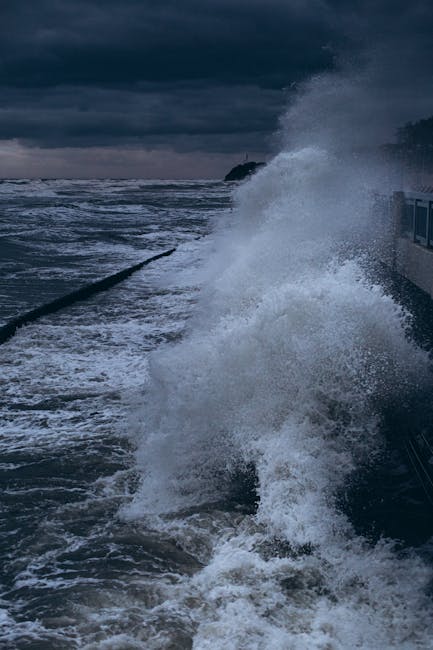Understanding Nor’easters: A Deep Dive into Powerful Winter Storms
Nor’easters, also known as northeasters, are powerful winter storms that impact the East Coast of North America. These cyclones are characterized by strong winds, heavy snowfall, blizzard conditions, coastal flooding, and significant wave action. Their impact extends far beyond just inconvenience, often leading to power outages, property damage, and even loss of life. This comprehensive guide will explore the meteorology, impacts, and preparedness strategies associated with these formidable weather events.
Meteorological Formation of Nor’easters
The formation of a nor’easter is a complex interplay of atmospheric conditions. It typically begins when a low-pressure system develops along the East Coast, often interacting with a mass of cold, dry air from Canada or the Arctic and a warm, moist air mass from the Atlantic Ocean. This interaction leads to a strong pressure gradient, resulting in powerful winds that swirl counter-clockwise around the low-pressure center. The name “nor’easter” stems from the direction these winds blow from – the northeast.
Several factors contribute to the intensity of a nor’easter:
- Temperature gradient: A large difference in temperature between the air masses fuels the storm’s intensity.
- Moisture content: High moisture levels in the warm air mass provide ample fuel for heavy precipitation.
- Jet stream interaction: The positioning and strength of the jet stream, a high-altitude river of fast-moving air, significantly influence the storm’s track and intensity.
- Ocean temperature: Warmer ocean waters provide additional energy and moisture, intensifying precipitation.
Types of Precipitation and Impacts
Nor’easters are capable of producing a variety of precipitation types, depending on the temperature profile of the atmosphere. Heavy snowfall is a common feature, often resulting in blizzard conditions with reduced visibility and significant accumulation. Coastal areas are particularly vulnerable to heavy rainfall and intense coastal flooding due to storm surge and high tides. The combination of heavy snow, strong winds, and coastal flooding can lead to significant damage and disruption.
The impacts of nor’easters can vary widely, depending on the storm’s intensity, track, and duration. Some of the most significant impacts include:
- Power outages: Strong winds can down power lines and trees, leading to widespread power outages that can last for days or even weeks.
- Travel disruptions: Heavy snow and strong winds make travel extremely hazardous, leading to road closures and flight cancellations.
- Coastal flooding and erosion: Storm surge and high tides can cause significant coastal flooding, damaging homes and businesses, and eroding shorelines.
- Property damage: Strong winds can damage buildings, trees, and other structures. Heavy snow can cause roof collapses.
- Loss of life: In severe cases, nor’easters can lead to fatalities, due to hypothermia, traffic accidents, or drowning.
Predicting and Tracking Nor’easters
Meteorologists use a variety of tools and techniques to predict and track nor’easters, including weather satellites, radar, and computer models. Accurate forecasting is crucial for issuing timely warnings and allowing individuals and communities to prepare for the storm’s impact. The National Weather Service (NWS) plays a vital role in monitoring and forecasting nor’easters, providing critical information to the public and emergency management agencies.
Improved forecasting technology has significantly enhanced the ability to predict the intensity and track of nor’easters, leading to more accurate and timely warnings. However, predicting the exact location and intensity of these storms remains a challenge, due to the complex interaction of atmospheric conditions.
Preparing for a Nor’easter
Preparation is key to minimizing the impacts of a nor’easter. Individuals and communities should develop a comprehensive preparedness plan that includes:
- Developing an emergency plan: This plan should outline evacuation routes, communication strategies, and essential supplies.
- Gathering emergency supplies: Stock up on non-perishable food, water, batteries, flashlights, first-aid kit, and medications.
- Securing your property: Bring loose objects inside, trim trees near your home, and protect windows and doors.
- Monitoring weather forecasts: Stay informed about the storm’s progress and heed any warnings or advisories issued by the NWS.
- Knowing your evacuation zone: If you live in a coastal area, understand your evacuation zone and plan your evacuation route.
Historical Nor’easters: Notable Examples
Throughout history, numerous devastating nor’easters have impacted the East Coast. These storms highlight the immense power and destructive potential of these weather events. Notable examples include the Great Blizzard of 1888, the Blizzard of 1993, and the Presidents’ Day Storm of 2023, all of which caused widespread damage, disruption, and loss of life. Studying these past events provides valuable insights into the potential impacts of future storms and the importance of preparedness.
The Economic Impact of Nor’easters
The economic consequences of nor’easters can be substantial, impacting various sectors of the economy. Damage to infrastructure, business closures, disruptions to transportation, and the costs associated with cleanup and recovery efforts all contribute to significant economic losses. The insurance industry also faces substantial claims following major nor’easters. Understanding the economic impacts is crucial for developing effective mitigation and recovery strategies.
Climate Change and Nor’easters
The potential influence of climate change on nor’easters is a subject of ongoing research. Some studies suggest that rising sea levels could exacerbate coastal flooding during these storms, while warmer ocean temperatures could potentially increase their intensity. Further research is needed to fully understand the complex relationship between climate change and the frequency and severity of nor’easters.
Conclusion: Preparedness and Resilience
Nor’easters are a significant weather hazard for the East Coast of North America. Understanding their formation, potential impacts, and preparedness strategies is crucial for minimizing their effects. By combining improved forecasting, effective planning, and community-level resilience, we can better protect lives and property from the formidable power of these winter storms. Continual research and advancements in meteorology will undoubtedly improve our ability to predict and prepare for future nor’easters, safeguarding communities from their potentially devastating consequences.

